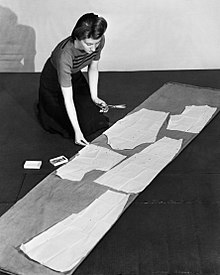Sewing pattern
In tailoring, the paper templates ( pattern pieces) according to which the fabric is cut are called cutting patterns . The job title of the pattern maker is tailor .
As a rule, most manufacturers offer the cuts for a specific model in several sizes. The two-dimensional pattern represents a three-dimensional item of clothing broken down into individual parts.
History and Development
The forerunners of the pattern sheets were small-format sectional drawings in German fashion magazines of the 18th century with instructions for tailoring. The American entrepreneur Ebenezer Butterick improved the actual size patterns as they were printed since the 19th century by adding allowances for different sizes to the patterns from 1863 and printing everything on sheets of thin paper to save postage and paper. Since around 1900 at the latest, there were "cut sheets" or "cut sheets" printed on both sides in Germany, on which the parts were arranged overlapping and marked with distinguishable line patterns. The parts were therefore no longer cut out directly from such sheets, but had to be transferred to a second sheet using copy paper or a toothed copy wheel .
Even then, certain fashion publishers had their own "pattern departments" for their distribution. By Aenne Burda magazine Burda Moden , which turned not only targeted at experienced seamstresses, but on average clever women of the postwar period was facilitated self-cutters from patterns and popularized in Germany.
Single cuts
A pattern in which all pattern pieces are arranged next to each other on the sheet is also called a single or finished cut. The individual parts can easily be cut out in any size. A single pattern usually consists of a pattern sheet, sewing instructions and a model picture. Drawings and step-by-step instructions also make sewing easier.
Pattern sheet
All cuts in a booklet are shown on the pattern sheet. In order to accommodate everything, the sheets are printed on both sides and the cut pieces are arranged as space-saving as possible. The individual parts overlap, which is why they cannot simply be cut out. In order to sew a certain model, the corresponding cut is "traced" with special copy paper or on foil , tissue paper, etc. Ä. Drawn through. A system of special contour lines (size lines), different types of lines (dashed, dotted, solid), numbers and colors helps with tracing .
Chalk or a copy wheel can be used to transfer the pattern onto the fabric , paying attention to the grain of the thread . This is usually indicated for each individual part by an arrow on the form.
On the template of a pattern, there are often additional information to make processing easier:
- So-called "notches" (also "pinches") mark areas for cutting. They protrude inwards from the outer edge at a 90-degree angle and are very short - they often mark an edge on opposite sides where the fabric should later be folded or turned over. Due to the seam allowance of an average of one to two centimeters already included , the pinches are no longer contained in the finished workpiece.
- Break lines: they are recorded within a template and are usually not drawn through to the outside in order not to be accidentally cut.
- In some pattern pieces, center lines (center front or center back) are also marked.
- Some instructions use quilting templates: In contrast to the usual cutting templates, these are not intended for cutting the fabric, but are transferred to an already cut piece with chalk or similar and mark a seam that is not along an edge but in the middle of the fabric is set.
- If available, lines can be drawn in for the breaks in the documents. In these cases, vouchers represent gussets that are not sewn in from a separate piece, but are created by repeatedly turning edges.
Literature on creating sewing patterns
- Guido Hofenbitzer: Clothing. Pattern construction for women's fashion. Volume 1: Clothing, Basics. Europa-Lehrmittel, Haan-Gruiten 2009, ISBN 978-3-8085-6236-9 .
- Dennic Chunman Lo: Pattern development . Stiebner, Munich 2011, ISBN 978-3-8307-0875-9 .



